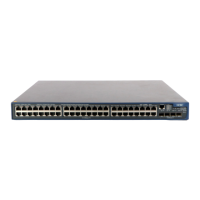1-25
traffic-priority
Syntax
traffic-priority { inbound | outbound } acl-rule { { dscp dscp-value | ip-precedence { pre-value |
from-cos } } | cos { pre-value | from-ipprec } | local-precedence pre-value }*
undo traffic-priority { inbound | outbound } acl-rule
View
Ethernet port view
Parameters
inbound: Performs priority marking on the inbound packets.
outbound: Performs priority marking on the outbound packets.
acl-rule: ACL rules to be applied for traffic classification. This argument can be the combination of
multiple ACLs. For more information about this argument, refer to
Table 1-4 and Table 1-5. Note that the
ACL rules referenced must be those defined with the permit keyword.
dscp dscp-value: Sets the DSCP precedence, ranging from 0 to 63. You can also provide one of the
keywords listed in
Table 1-7 for the dscp-value argument.
ip-precedence { pre-value | from-cos }: Sets the IP precedence. You can assign a value in digits in the
range of 0 to 7 for the pre-value argument or in words as shown in
Table 1-6. Alternatively, you can
specify the from-cos keyword for the switch to extract the 802.1p priority for the IP precedence.
cos { pre-value | from-ipprec }: Sets the 802.1p priority. You can assign a value in digits in the range of
0 to 7 for the pre-value argument or in words as shown in
Table 1-10. Alternatively, you can specify the
from-ipprec keyword for the switch to extract the IP precedence for the 802.1p priority.
Table 1-10 802.1p priority values in words and in digits
802.1p priority (in words) 802.1p priority (in digits)
best-effort
0
background
1
spare
2
excellent-effort
3
controlled-load
4
video
5
voice
6
network-management
7
local-precedence pre-value: Sets the local precedence. The pre-value argument ranges from 0 to 7.
Description
Use the traffic-priority command to configure priority marking on a port.
Use the undo traffic-priority command to remove the priority marking configuration.
This command is used to set precedence for traffic matching a specified ACL rule:

